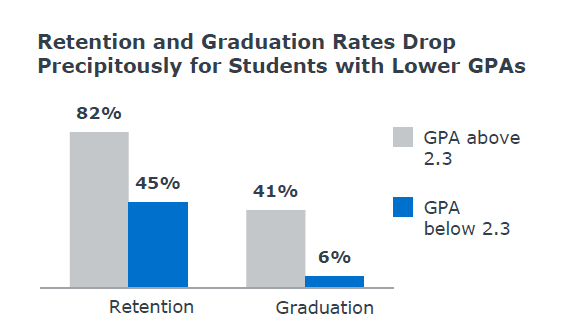How one university restores students' sense of self-efficacy when they stumble
May 19, 2020
Editor’s note: EAB’s Annie Yi and Natalia Alvarez Diaz presented this information at our national Student Success Collaborative summit, CONNECTED19. Their speech has been lightly edited and adapted for the web by Emily Arnim.
During their journey through college, students are tasked with making hundreds of decisions. Some of these decisions occur at key moments of transition, and at EAB, we call these pivotal moments. Through our research, we’ve found that in order for students to navigate these moments successfully, colleges and universities need to not only elevate the moments that matter, but also imbue those moments with insight.
And yet despite our best efforts, many students will still stumble off track. For the students who stumble and face difficulties navigating a moment of transition, their next steps could mean the difference between attaining a degree and stopping out.
The problem: Students do not know how to get back on track if they stumble
Students who fall into a pit when navigating pivotal junctions—that is, students who failed a course required for their major or who missed the FAFSA deadline, for example—often discover that there is little guidance for getting back on track. Additionally, their stumbles are often framed as failures or are communicated in punitive terms. This leads students to experience shame, isolation, and a diminished sense of belonging. Amid these feelings, students remain unsure about the best path forward.
The solution: Frame stumbles as an opportunity for growth
To help students get back on track, we found that student success leaders generally follow three steps. By following these steps, student success leaders are able to not only fill the pit students fell into, but also turn that pit into a peak.
-
First
Student success leaders provide a clear path to recovery, communicating with students in a way that makes them feel capable and providing them with clear steps forward.
-
Second
Student success leaders connect students who are facing difficulties with others who have faced failure and have been able to recover and thrive.
-
Third
Student success leaders reframe failure so that students not only feel capable of recovery, but also strengthened by their experience.
Partner Story: University of the Virgin Islands (UVI)

At UVI, students who struggled academically in their first few semesters were less likely to persist and graduate, university leaders found. In fact, students with a GPA below 2.3 had just a 45% retention rate and a six percent graduation rate, compared with an 82% retention rate and a 41% graduation rate for students with a GPA above 2.3.
Originally, UVI’s remediation process included advisors encouraging students to repeat the course or courses for which they earned a low grade, with the potential for replacing the low grade with a higher one on their transcripts. This process included no additional support or guidance for students.
To help students improve their academic standing more deliberately, UVI designed a program called Summer Boost. Summer Boost aims to help students not only improve their GPAs with course correction, but also regain their footing overall.
Summer Boost’s approach to academic remediation
-
Flexible Academics
- Not major- or course-specific
- Designed for students with a <2.3 GPA in their first 24-30 credits
-
Free Tuition
- Free for students; funded via grants and private donations
- Five-week, full-time, on-campus program
-
Academic Coaching
- Pairs students with a peer academic coach and with Center for Student Success advisors
But UVI didn’t want to create an experience that would make students feel singled out for the ways in which they had failed. Rather, they wanted to provide a space for students to reflect about what had prevented them from succeeding, and what they could change moving forward.
During Summer Boost, students are paired with a peer academic coach and an advisor as they prepare to retake a class that they earned a C or below in. They focus on non-cognitive skills, such as innovation, problem-solving, and self-efficacy and discuss what they will do to succeed when retaking the class. For example, advisors might ask students questions such as, “What didn’t work last time?” and “What do you need more support on?”
The program also makes students feel special by implementing a competitive admissions process in which students are invited to apply and must interview. Once in the program, students must also complete and present a research project in front of a group of UVI’s most prestigious faculty.
Since implementing the program, UVI reports that they have seen a 32 percentage point increase in persistence rate for Summer Boost students, as well as a 12 percentage point increase in participants’ credit completion from spring to fall term.
More Blogs

How to navigate policy challenges and show support for your trans students

3 hidden retention challenges facing higher ed in 2025
